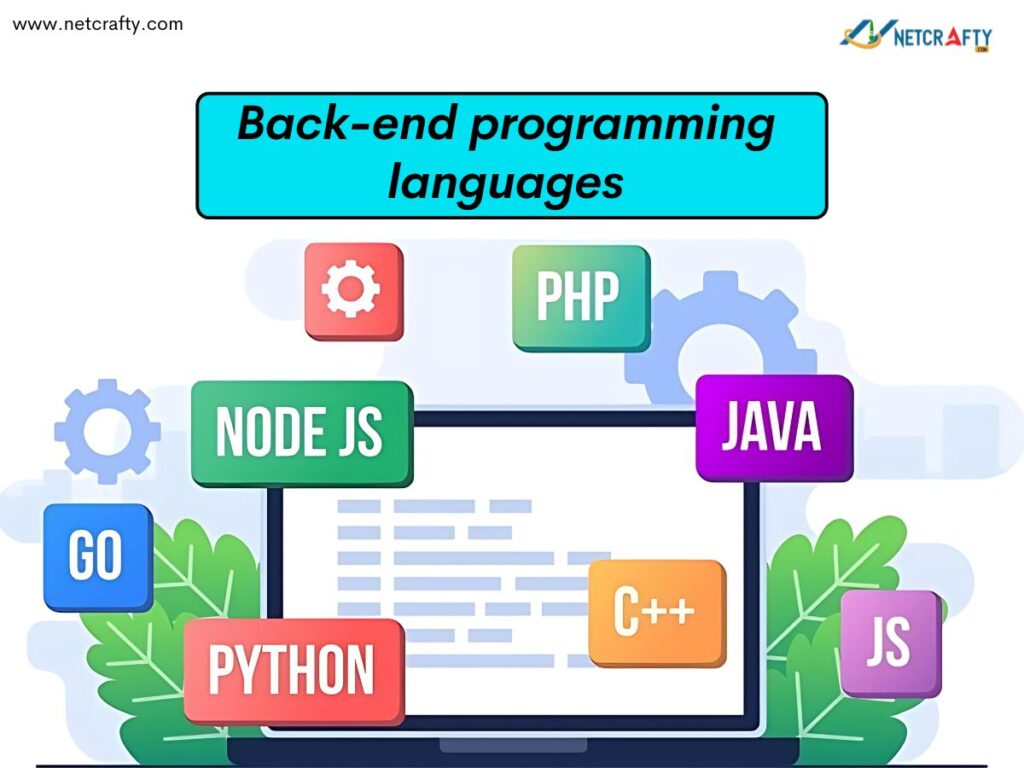As a back-end developer, you can choose from several scripting languages with distinct features. They can differ in file size, performance, compatibility, coding requirements, and programming style.
Another important distinction is how they are executed, affecting load speed, readability, and the computing power required to run the application.
The following are some of the most common back-end programming languages available today:

C++: It combines all of the benefits of C with object-oriented programming concepts such as classes. As a low-level programming language, it interfaces with system hardware more effectively, making it excellent for massive web applications.
C#: It is mainly utilized on Windows servers and systems. If your technological stack includes Microsoft technologies compared to ASP.NET, C# is likely to be the most productive option for your developers.
Java: This is a generic, object-oriented programming language designed with cross-platform compatibility in mind. Java programs can execute on any machine with Java Virtual Machine (JVM) installed.
Node.js: Node.js is a server-side runtime environment that executes JavaScript code outside a web browser. It is based on Chrome’s V8 JavaScript engine, which compiles and executes code efficiently, resulting in fast and scalable network applications.
PHP: This is the most common back-end language for the web. PHP offers a minimal learning curve, a large codebase, and strong community support.
Python: Python is a general-purpose programming language that contains a collection of data processing components. Python’s easy syntax and minimal code length improve productivity in back-end development.
What are the principles and techniques of Back-end development?
To create high-performance and dependable apps, you must adhere to specific software development concepts and methodologies. Here are some best practices for developing high-quality back-end systems:

- Modularize your code: Instead of writing one massive block of code, consider splitting it into smaller, more manageable portions (modules). This makes your code reusable, which increases your productivity in the long term. Furthermore, it makes it easy to detect faults and defects while testing.
- Use design patterns: Don’t wing it. To create high-quality back-end apps, follow tried-and-true web design paradigms such as MVC (model view controller).
- Stick to code standards: Adhere to industry standards and style guides to make your code manageable and legible. This will make it easy for you to work with other team members.
- Use version control: Git and other solutions enable you and your team to keep track of codebase changes. In this manner, you may avoid confusion while upholding high-quality standards.
- Document your code: Even if you understand what your code does, other team members may need to be more familiar with specific concepts. Adding in-line comments to your code allows others to follow along easily.
- Test: If your back-end program fails in production, it can be catastrophic and degrade the user experience. Test your application in many settings to reduce the likelihood of this happening.
What is the difference between front-end v/s back-end development?
Understanding the back end, or “server side,” requires understanding the front end and how they interact:
The front end, commonly known as “client-side” programming, refers to anything users see and interact with within the browser. The back end, on the other hand, takes place on the server and database. It is the machinery that operates behind the scenes, which the end users do not see or interact with directly.
Front-end scripts play a crucial role in the interaction with the back end. They continuously transmit user requests to the server for processing and then return the relevant data to the front end, creating a dynamic cycle of requests and responses.
The back end consists of the server, databases, APIs, and operating systems that power an app’s front end.
The back end of applications can be diverse, with each application potentially using different technologies. Whether it’s cloud-based servers and data warehouses, containerization with services, Backend-as-a-Service (BaaS) providers, or APIs, the back end can adapt to the application’s specific needs.
The back end is responsible for the logic interaction and performance of the application with Python, JavaScript, and others. On the other hand, the front end uses web languages like HTML, CSS, and others.
The back end is the powerhouse that fuels an app’s front end. It consists of the server, databases, APIs, and operating systems, all working together to ensure the front-end functions as intended.
An application’s backend can vary greatly depending on whether it employs cloud-based servers and data warehouses, containerization with services, Backend-as-a-Service (BaaS) providers, or APIs to replace more complex processing.
The back end is in charge of the application’s logic, interaction, and performance, using Python, JavaScript, and other languages. On the other hand, the front end uses web languages such as HTML, CSS, and others.

Leave a Reply